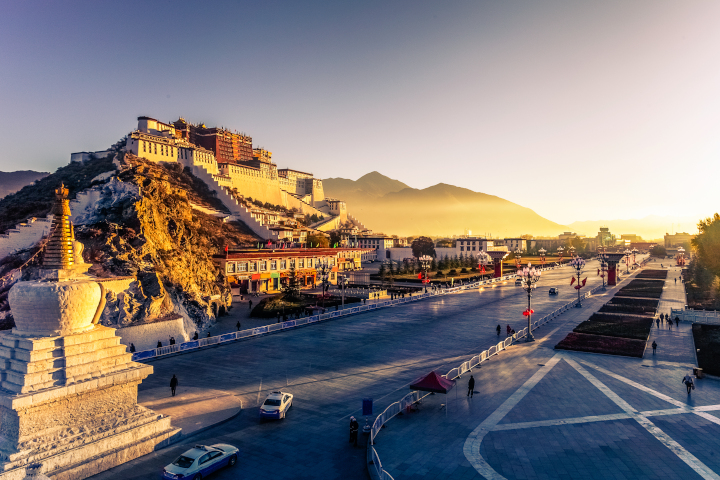
Tibet
The lost ‘Shangri-La’, Tibet is a land full of wonders. An autonomous region of the People’s Republic of China, Tibet is full of unique natural diversity, a rich Buddhist cultural and archaeological heritage and home to revered religious sites such as Mount Kailash, and the charismatic wonders of Lhasa. Containing the highest plateau in the world and nicknamed the ‘Land of Snows’, Tibet offers fabulous monasteries, breathtaking high altitude treks, spectacular views of the world’s highest mountains and one of the friendliest people you will ever come across. Awesome lakes, huge plains dotted with yaks and wanderers’ tents, prayer flags, the remains of remote hermitages and some of the world’s wildest roads are all part and parcel of a trip in Tibet.
Landscape and Geography
Tibet’s geography was formed by the slow uprising of the tectonic plates that gave birth to the Himalayas. The world’s largest plateau, the Tibetan plateau is surrounded by the Himalayas, Kailash and Pamir mountain ranges, and has an enormous number of glaciers that are the source of Asia’s largest rivers including the Ganges, the Mekong and the Yangtze, providing water for around one-third of the world’s population.
With an average elevation of over 4000 meters, the terrain of Tibet is rough and difficult. It represents about a quarter of Chinese territory yet has only 1/500th of its population. However, this tough landscape is charming due to its marvellous variety. With turquoise lakes, deep valleys, emerald green forests, glittering snow mountains, extensive grassland, and wild desert it is exceptionally beautiful. Tibet is forested in the eastern region and has open grassland in the north which is used by nomads for grazing yaks and sheep. Its terrain changes to an agricultural landscape in the central and southern region where the major Tibetan cities Lhasa, Shigatse, Tsetang and Gyantse are situated.
Environment
The uniqueness and diversity of the geography of Tibet has led to equally diverse environments and biodiversity. It is home to more than 100,000 plant species including 2,000 species of medicinal plants used in the traditional medicine system of the country. It has one of the largest forest areas remaining in China with well preserved primeval forests. Alpine and fungal species are the major components of its vegetation. Tibet is also home to some of the rarest wild animals in the world. About 142 species of mammal, 473 species of birds and more than 2300 species of insects are found here, including the very rare white-lipped deer. Tibet also has deposits of about 126 different kinds of minerals, particularly gold, chromite, iron and copper.
Culture, Tradition and Religion
Tibetan Buddhism preserves the Vajrayana teachings of the eighth century. Tibetan stupas are built in eight major styles: Enlightenment, Bodhi, Dharmachaka, Miraculous Transformation, Descent, Harmonious, Vijaya Victorious, and Nirvana.
Though home to the Dalai Lama’s own culture, the presence of other diverse ethnic groups mean that many colourful festivals adorn these high lands. Tibetan New Year (also known as the Losar festival) is the most important festival, but others include the Shoton festival, the Chawalong Horse Racing Festival, and the Butter Lantern Festival. The spiritual Tsurphu Monastery festival involves the unfolding of great Thangka, whereas the Naqu Horse festival is more physical with a tug of war, stone lifting and Tibetan operas as well as its focus – the racing of horses.
Sky Burial is a unique funeral ceremony followed in Tibet. The corpse is offered to the vultures, the Tibetan equivalence of angels that take the soul into the heavens. Tibetans are encouraged to view this ritual to confront death openly and feel the transience of life. Thangka paintings, prayer flags, food, religion, language, songs, dances and the tending of yaks are all important cultural activities for the peoples of this immense plateau.
Tibet Travel Permits
Divided into six prefectures and one municipality, multiple documents are needed to visit Tibet. We can help in arranging these.
• Chinese visa.
• Tibet permit issued by the Tibet Tourism Bureau (TTB). This gives entry to Lhasa and some other parts of the Tibet Autonomous Region.
• For travelling to ‘unopened’ areas of Tibet such as Mount Everest Base Camp in Shigatse, Samye Monastery in Tsedang and other listed areas, an Alien’s Travel Permit issued by the Public Security Bureau is required.
• For travelling to more sensitive areas like Mount Kailash and Rokyo lake military area a special entry permit is required, along with a foreign affairs permit and also permits from the relevant Local Cultural Antiquities offices.
Attractions
The major attractions of Tibet are the Chamdo Region, Lhasa region (famed for its rich historical and cultural relics), Shigatse Region, Chambling Monastery, Potala Palace (the winter palace of the Dalai Lamas), Heavenly lake Namtso (the highest saltwater lake in the world.), the Ngari region, Mt. Kailash and Manasarova Lake, the ruins of Guge Kingdom, the Samye Monastery and the Mount Everest region. Jokhang Temple forms the spiritual centre of Tibet.










